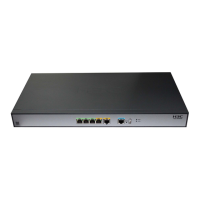58
Configuring AP operating mode
A WLAN consists of various APs that span across the building offering WLAN services to the clients.
The administrator may want some of these APs to detect rogue devices. The administrator can
configure an AP to operate in any of the three modes, normal, monitor, or hybrid.
• In normal mode, an AP provides WLAN data services but does not perform any scanning.
• In monitor mode, an AP scans all Dot11 frames in the WLAN, but cannot provide WLAN
services. An AP operating in this mode cannot provide WLAN service, and you do not need to
configure a service template.
• In hybrid mode, an AP can both scan devices in the WLAN and provide WLAN services. For an
AP operating in this mode, you need to configure a service template so that the AP can provide
WLAN service when scanning devices.
To configure the AP operating mode:
Step Command Remarks
1. Enter system view.
system-view
N/A
2. Configure the AP operating
mode.
• Configure the AP operating
mode as monitor:
wlan work-mode monitor
• Configure the AP operating
mode as hybrid:
wlan device-detection
enable
Use either command.
By default, the AP operating
mode is
normal
.
• When an AP has its
operating mode changed
from normal to monitor, it
does not restart.
• When an AP has its
operating mode changed
from monitor to normal, it
restarts.
Configuring attack detection
Configuring attack detection
Step Command Remarks
1. Enter system view.
system-view
N/A
2. Enter IDS view.
wlan ids
N/A
3. Enable IDS attack
detection.
attack-detection enable
{
all
|
flood
|
spoof
|
weak-iv
}
By default, IDS attack detection
is disabled.
Displaying and maintaining attack detection
Task Command Remarks
Display all the attacks detected
by WLAN IDS IPS.
display wlan ids history
[
|
{
begin
|
exclude
|
include
}
regular-expression ]
Available in any view.
Display the count of attacks
detected by WLAN IDS IPS.
display wlan ids statistics
[
|
{
begin
|
exclude
|
include
}
regular-expression ]
Available in any view.

